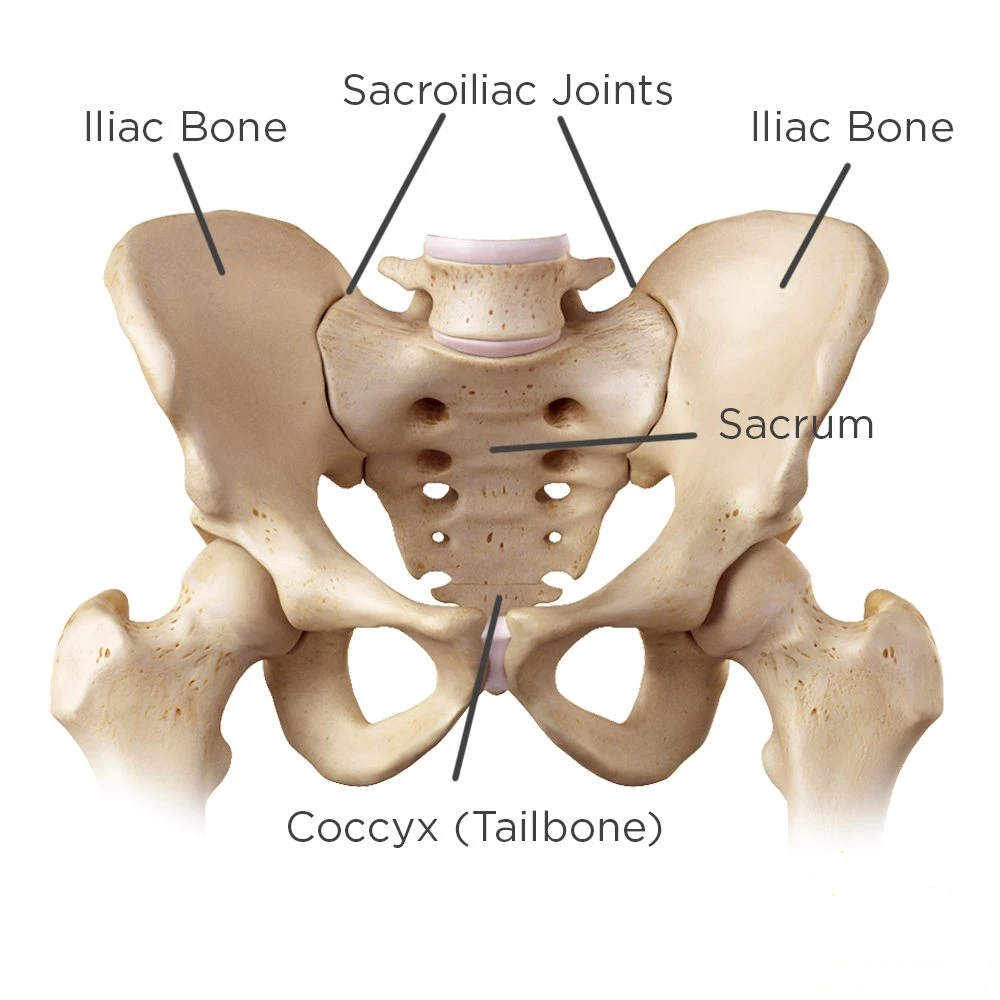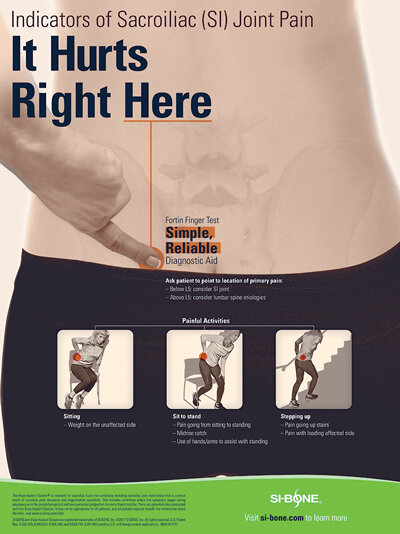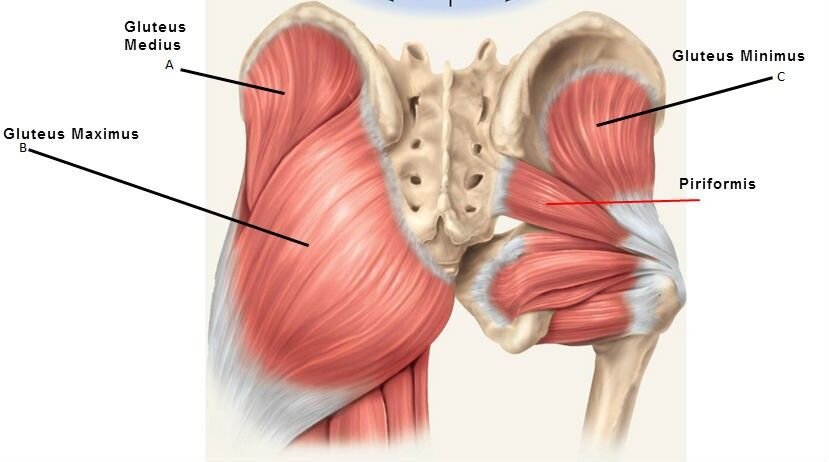Week 3: SI Joint Dysfunction and Low Back Pain
This week I am going to talk about SI Joint Dysfunction, SI Joint Pain, and a little bit about low back pain and a lot of misunderstanding that goes along with that. In my practice, I take care of a lot of SI joint dysfunction, SI joint pain, and SI joint laxity so I’ll walk through what I typically see in my patients at my office. I’ll review what the possible causes of pain are and what the pain is sometimes misdiagnosed as.
Picture from braceability.com
SI Joint Anatomy
As you can see in this picture, the SI joint is not like any other joint that hinges or moves a lot. It actually appears that if it’s designed not to move. Overlying the joint are what we call the posterior sacroiliac ligaments which blend into the sacrotuberous ligament, and those essentially locks the SI joint together. Although the SI joint is similar to other joints in the fact that it does have synovial portion - or joint fluid and everything else in it - it is unlike other joints in the fact that these ligaments allow transition of forces through the joint, but not necessarily motion through the joint. So when you bend over, you’re actually hinging at your hip and not your SI joint.
Pinpointing SI Joint Pain
When you’re walking or running, you land on the ground, trans forces go up through your leg, through your pelvis, in your back, and your arms and wherever else it spread. So as we come across low back pain, which is often time SI joint pain, it’s difficult to discriminate. However, in most cases, people with SI joint dysfunction or SI joint pain, will point to the SI joint when asked to describe their pain. They’ll actually reach back with their thumb or finger and point directly at the SI joint - right at the top of the sacrum, which is below the lumbar spine. The sign for this is called the Fortin finger sign because it is pretty specific for SI joint pain.
Causes of SI Joint Pain
As I discussed with the anatomy, the SI joint is not supposed to move a lot. So when someone is experiencing SI joint pain, it is most likely because there is too much movement or laxity in the joint. Due to women’s genetics, that unfortunately means that females experience SI Joint dysfunction more often than males. The biggest reason for this is female hormones as the fluctuations of estrogen and progesterone affect connective tissue. Additionally, during pregnancy, there is a hormone released by the corpus luteum called relaxin causing relaxation of the ligaments. Then after delivery, oxytocin and prolactin - the two hormones that promote milk production - also have a tendency to relax ligaments. Although men can and do suffer from SI joint dysfunction, it is much more prevalent in women.
Knowing these facts, we can safely say that the major pain generator is generally the ligaments rather than the joint itself. To correctly and specifically diagnose the pain generator, you may consider injecting the ligaments either with lidocaine or marcaine or even a steroid. If you opt for an injection, it will be much more effective and rewarding in pain reduction to inject the ligaments rather than to inject the joint itself. This can be done using ultrasound guidance or some sort of guidance technique to ensure that you’re actually injecting the ligament. If your pain goes away with that injection, then you most likely have ligamentous pain and SI joint dysfunction.
Treating SI Joint Pain
A big question once you’ve diagnosed your pain, is how do you treat it? This is a hard question because the problem with laxity of ligaments is that the pain won’t respond well to stretching. Unfortunately, I’ve come across a lot of information online instructing those with SI joint dysfunction to go ahead and stretch and stretch it like crazy, but it will not fix the problem. To help patients in my clinic, we do a lot of exercise prescriptions to focus on strengthening specific muscles.
So we are going to circle back to some anatomy and discuss some of the important muscles in SI joint dysfunction.
The gluteus medius is the major stabilizer of the SI joint. Based on its location, it is an external rotator of the hip. So if you think about the function of the gluteus medius, you think about an ice-skating muscle or roller skating and rollerblading muscle. You use that muscle with the out and back motion of your leg. So if the SI joint becomes destabilized secondary to hormones, trauma, or overuse, the next best option beyond the ligaments for stabilizing the SI joint is the surrounding muscles. Better than stretching, would be to strengthen those muscles by starting an exercise program that promotes overall health of the gluteus medius - focusing on both strength and coordination of movement. What exercises promote health of the gluteus medius? Walking uphill or walking sideways are both great ways to activate that muscle. Activities using a resistance band that move the leg out and back from your body are great exercises.
Another treatment that many seek out is adjustments. Being a specialist in Osteopathic Manipulation myself, this is a treatment that I even offer for many. However, with that being said, I would offer a word of caution when seeking that type of treatment for SI pain. If adjustments are forceful, they take a lot of force through your SI joint to get it where you want it to be or to make it feel better because sometimes the shift of the joint does make it feel better. However, that force is causing you to stretch those ligaments. If you’re stretching ligaments that are already a little bit lax, it may not be the best idea. Please make sure your provider is using caution and you are incorporating exercise in conjunction with adjustments. For pregnant women suffering from SI joint pain, there have been several studies done that show osteopathic manipulation in conjunction with exercise is very effective in alleviating that low back pain.
If conservative treatment options such as exercise and osteopathic manipulation are not sufficient in treating your symptoms, we then look into injection therapies. Remember, as I mentioned, the muscles are the secondary stabilizer to the SI joint, whereas the ligaments are the primary stabilizer - so we move our focus beyond strengthening those surrounding muscles and focus on the primary stabilizer of that joint, but how do you rehab a ligament? There are some physical therapists that are qualified to do dry needling, which can stimulate a wound repair response with the acupuncture needles - which can be helpful for mild SI joint dysfunction or pain. However, for moderate to severe SI joint pain, you have to think beyond that and what will best stabilize that soft tissue. Regenerative injections work fantastic for SI dysfunction and SI joint laxity. The intent of a regenerative injection is to cause very specific inflammation to a targeted area to trigger a repair process to the posterior sacroiliac ligaments and the iliolumbar ligaments to stabilize the pelvis.
If regenerative injections still do not effectively take away your symptoms, we would then explore the possibility of using radiofrequency ablation - where you ablate (burn or cut) the nerves that go to the SI joint. This can be helpful, but it is not a long-term solution as this will generally last anywhere from a year to 18 months.
For those with extremely loose SI joints that are unlivable and unmanageable with everything else we’ve talked about, then surgery might be necessary. The surgery is quite invasive and a last option. With surgery, they will usually put three triangular rods through your ilium into your sacrum - this will fuse your sacrum together and will eliminate a lot of the pain. However, to get to that area, you have to go through your glutes, possibly a couple of arteries and nerves and you are in a wheelchair for about six weeks following the procedure. There are methods coming down the line for a little less invasive SI joint fixation, but it is still a big deal, so I would not recommend surgery unless every other conservative option has failed.



